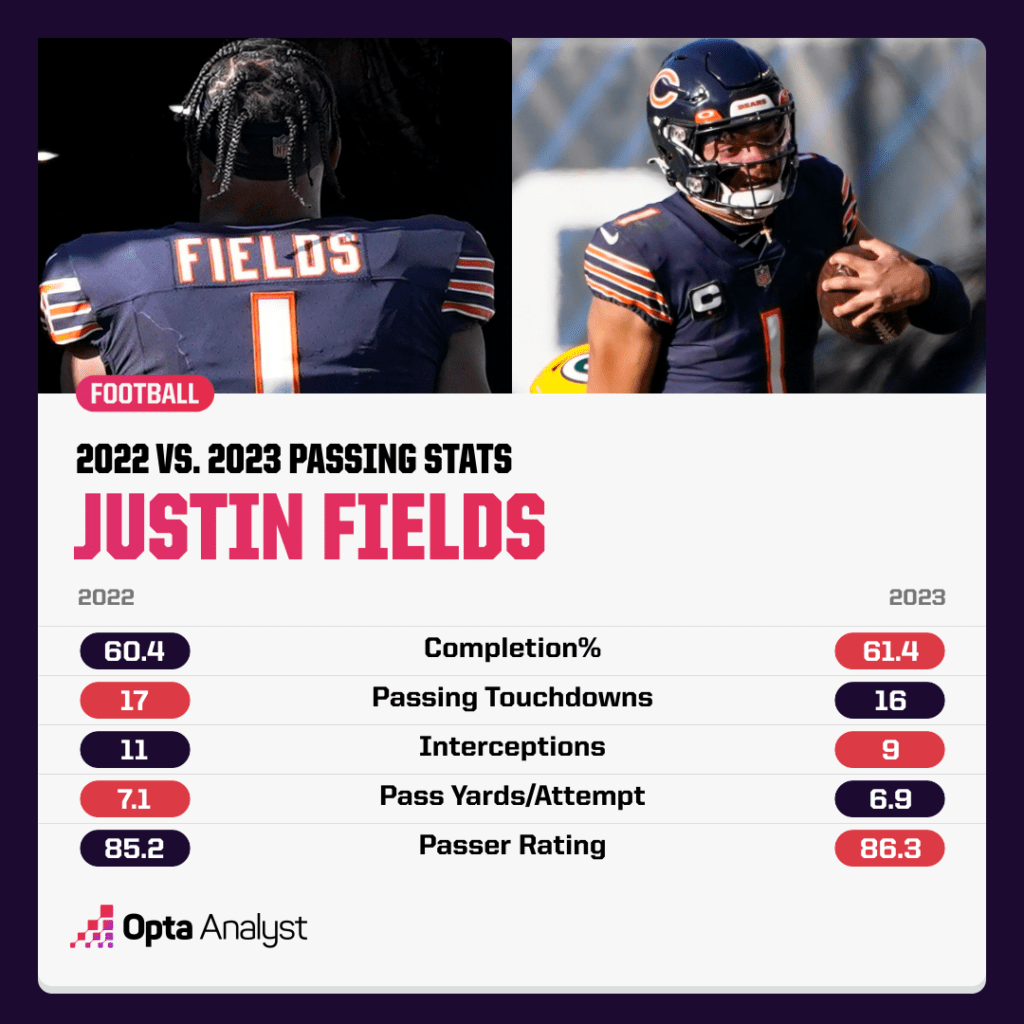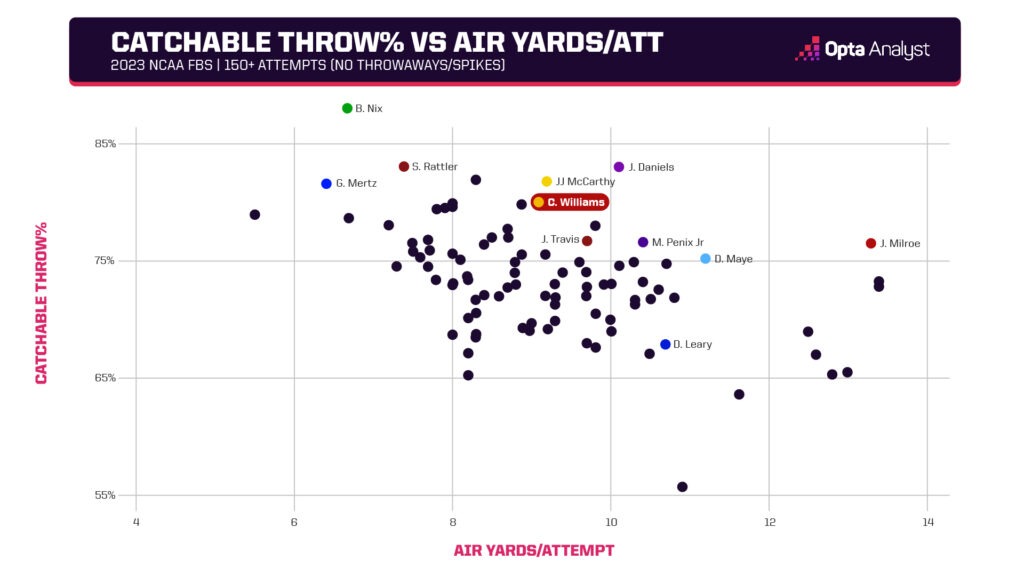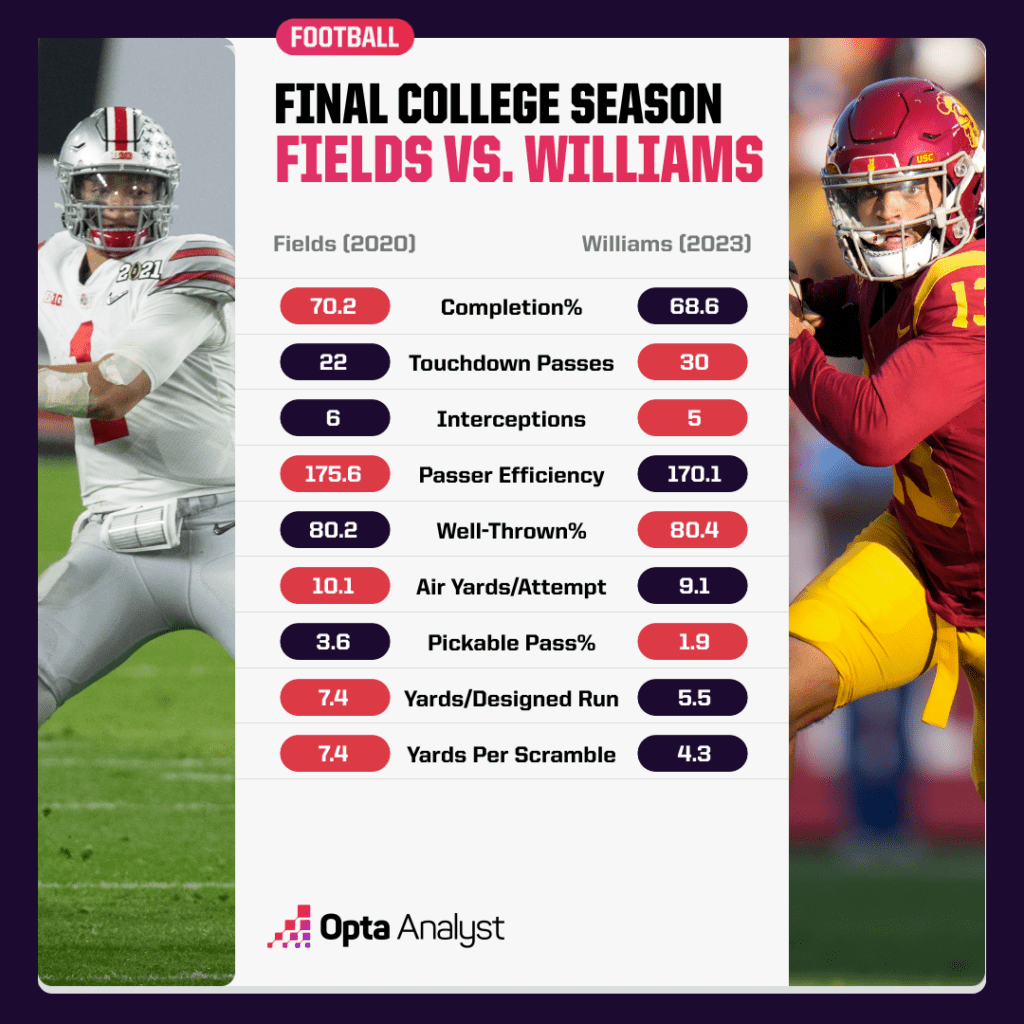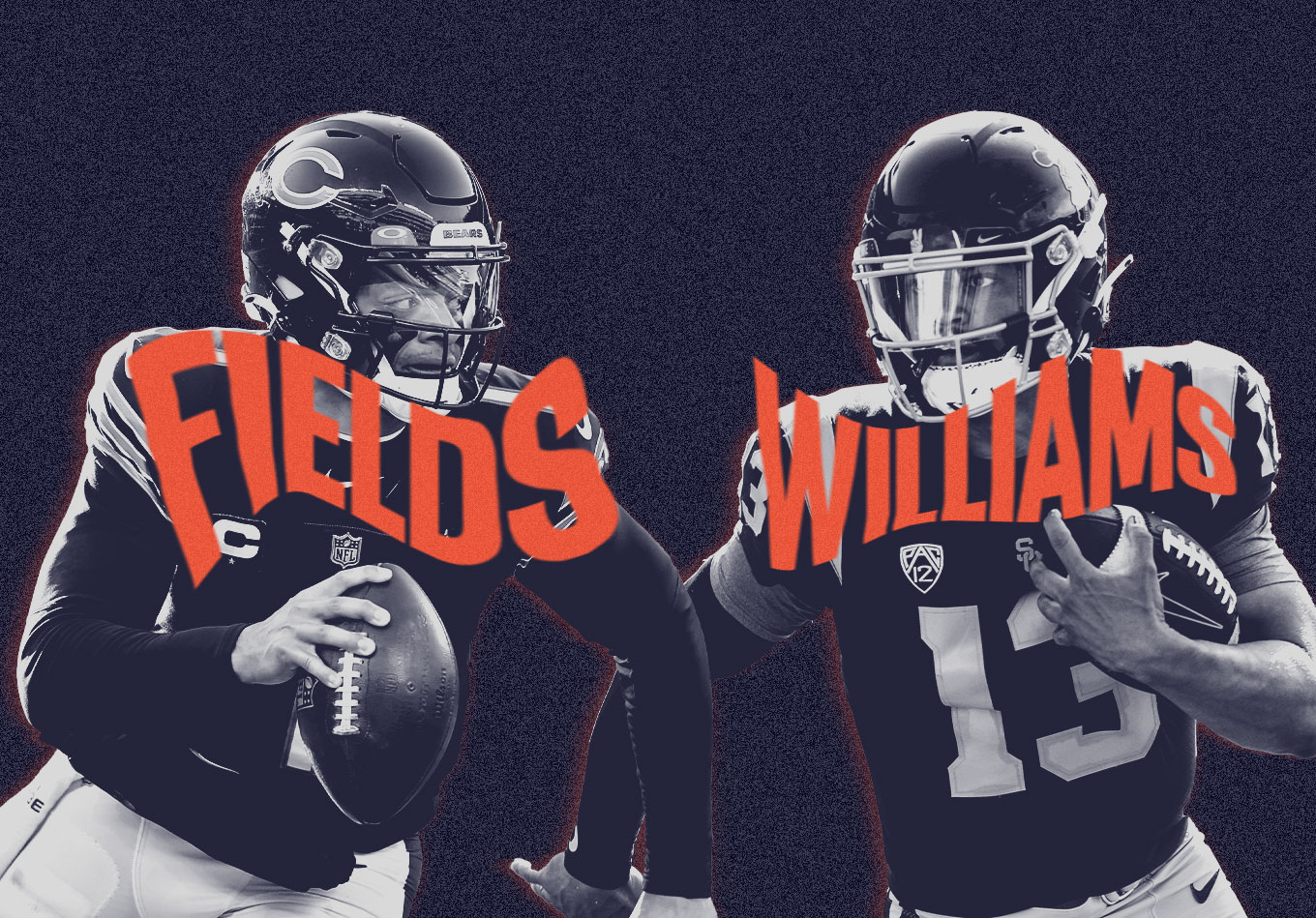One year after the NFL offseason was dominated by discussions about whether the Chicago Bears should give Justin Fields another year as the starter, or use the No. 1 overall pick on Bryce Young or C.J. Stroud, we’re right back where we started.
The name itself is different, with Caleb Williams being the presumptive No. 1 overall pick in just about every NFL mock draft imaginable. But the other aspects of the situation are the same.
Chicago again has the top draft pick – thanks to the Carolina Panthers trading up with the Bears last year to select Young – and is again coming off a sub-.500 season, with a potentially franchise-altering decision coming. Ride with Fields for one more year, or turn the reins over to a rookie?
While there’s no certain right answer given how the 2024 NFL Draft is an inexact science, we can break down some conventional and advanced statistics to give a glimpse into the Bears’ difficult choice.
Note: The NFL’s definition of a qualified passer is a player who has averaged at least 14 attempts per team game.
Fields’ Improvement?
Before even mentioning the name of Williams or any other draft-eligible quarterbacks, the first order of business is to diagnose whether Fields has been improving over the course of his pro career.
Strictly looking at team success, the Bears made some progress in Fields’ third season. Chicago’s seven wins were the most the team has had in his career, and 2023 was the Bears’ first time finishing in the top 20 in both scoring offense and total offense since 2013 – back during the days of Jay Cutler, Matt Forte and Alshon Jeffery.
While these are far from the most advanced metrics to measure offensive efficiency, they at least provide a starting ground when trying to provide historical context.
But evaluating the team is far different than evaluating the player, which is the Bears’ impetus here. When looking at Fields’ basic passing statistics, 2023 appears to be almost an exact clone of 2022.

Once we look into the advanced statistics, though, we can see how Fields’ game really changed in 2023. And when we do so, one specific trait that jumped out more than conventional stats might suggest was his improved accuracy.
There were 21 quarterbacks who were qualified in both 2022 and 2023. Fields’ well-thrown percentage on “true” attempts (no spikes/throwaways) increased from 75.6% in 2022 to 81.3% in 2023 – the third-largest increase among those 21 QBs.
Fields also had the sixth-largest increase among the same group in catchable throw percentage. And all of this came despite Fields remaining pretty aggressive in terms of downfield passing, as his 8.6 air yards per attempt ranked seventh among 32 qualified QBs in 2023 (compared to 9.1 in 2022).
Why did this improved accuracy not lead to significantly better raw passing numbers? Because, despite the acquisition of D.J. Moore in the aforementioned trade with Carolina, Fields did not target open receivers more frequently this season.
Fields’ 81.5% open target rate in 2022 was the third-highest among qualified passers, trailing only upcoming AFC championship participants Lamar Jackson of the Baltimore Ravens and Patrick Mahomes of the Kansas City Chiefs. This season, Fields’ number dropped to 78.4%, representing the fourth-largest decrease among the 21 qualifiers in both seasons.
As it pertains to Fields specifically, though, an increase in contested throws may not actually be a bad thing. How can this be the case? Because of the elephant in the room that we intentionally haven’t discussed to this point, given that it deserves its own section.
The Sack Conundrum
When questions pop up about Fields’ future as an NFL quarterback, they never center around his physical ability to throw or run the football. Instead, there is one core question: Can he avoid being sacked at a historically harmful rate?
The question has only gotten louder in the face of recent public research that has indicated that sacks are more of a “QB stat” than previously thought. And in 2022, the answer to the question was a firm no.
Fields was sacked on a staggering 14.8% of his drop backs in 2022, or roughly one out of every seven. That was the second-highest rate in NFL history by a player with at least 300 pass attempts, trailing only Don Meredith’s 15.2% with the 1964 Dallas Cowboys – back when rules were a little bit less friendly to quarterbacks than they are today.
Fortunately, 2023 saw Fields make a significant leap in this regard. Some credit can be given to the other changes the Bears made to their offense, such as trading for Moore, drafting tackle Darnell Wright with a first-round pick, and signing free-agent guard Nate Davis from the Tennessee Titans.
But nonetheless, Fields’ sack rate decreased to a career-low 10.6% in 2023, perhaps partially due to a willingness to embrace more difficult throws. This led to his career-best 5.5 net yards per pass attempt (which accounts for sacks) for the season.
The bad news? Even Fields’ best season to date in terms of sack avoidance would still be a career worst from almost anyone else. His 10.6% sack rate was second-highest among 32 qualified passers, trailing only Zach Wilson’s 11.1%. And each of Fields’ three professional seasons rank among the 10 highest single-season sack rates by qualified passers since 2010.
Highest Single-Season Sack Rates Since 2010
- 2022 Justin Fields, Chicago Bears: 14.8%
- 2021 Justin Fields, Chicago Bears: 11.8%
- 2018 Ryan Tannehill, Miami Dolphins: 11.3%
- 2018 Marcus Mariota, Tennessee Titans: 11.3%
- 2023 Zach Wilson, New York Jets: 11.1%
- 2018 Deshaun Watson, Houston Texans: 10.9%
- 2011 Tim Tebow, Denver Broncos: 10.9%
- 2010 Jay Cutler, Chicago Bears: 10.7%
- 2018 Russell Wilson, Seattle Seahawks: 10.7%
- 2023 Justin Fields, Chicago Bears: 10.6%
Furthermore, underlying metrics imply that Fields’ improvement in sack avoidance may be limited. In 2022, Fields comfortably had the highest average time to throw on “true” attempts among qualified QBs at 2.96 seconds. In fact, he has the highest average release time (2.94) of any NFL QB with at least 150 career attempts between 2016-23.
And then that number managed to get even larger in 2023, settling at an NFL-high 3.04.
Fields’ improved ability to avoid taking sacks was the primary catalyst for both he and his team having their best season in years. But for his sack rate to get closer to the NFL average, he will almost surely need to find ways to shave his time to throw in a sustainable manner.
Coming Out of College
Comparing Williams’ college numbers to Fields’ pro numbers would be a farce due to the steep differences in competition, but because Fields was in college relatively recently, we can compare how they were as NFL Draft prospects.
Williams finished outside the top 10 in Heisman voting after winning the award in 2022, leading common fans to believe his game dropped off as a junior. But this change in voters’ habits could have been due to some “voter fatigue” regarding Heisman winners who return to college, not to mention USC’s team-wide struggles in 2023.
Based on the numbers, any supposed decline from Williams was a harsh fallacy. He finished the 2023 season with collegiate career highs in completion percentage (68.6), pass yards per attempt (9.4) and pass efficiency rating (170.1). He simultaneously became the only FBS player since at least 2000 to have multiple seasons with 30 or more pass TDs, 10+ rush TDs and five or fewer interceptions – something that Fields also did once in 2019.
This concluded a legendary collegiate career in which Williams, despite only playing three seasons, joined Marcus Mariota as the only FBS players in the 21st century to finish with 10,000+ passing yards, 25+ rush TD and a 160+ pass efficiency rating.
And when we dive into stats far more complex than yards or touchdowns, Williams’ 2023 season continues to shine. The reigning Heisman winner’s well-thrown percentage jumped from 77.7 in 2022 to 80.4 this season, while his catchable throw percentage similarly leapt from 76.7 to 80.1. Even when accounting for this fall’s disastrous three-interception game at Notre Dame, his pickable pass percentage managed to drop from 2.3% to 1.9%.
Williams was one of only three FBS QBs (min. 150 “true” attempts) to finish with at least 9.0 air yards per attempt and a catchable throw rate of at least 80% in 2023, joining two other names that have similarly established themselves as college football royalty: Williams’ Heisman successor, Jayden Daniels, and national champion J.J. McCarthy.

How did all of this stack up to Fields? Though Fields’ final college season was limited to eight games due to the pandemic, he demonstrated elite accuracy.
Armed with elite wide receivers like Chris Olave and Garrett Wilson (along with Jaxon Smith-Njigba and Jameson Williams in smaller roles), Fields and Ohio State Buckeyes made it to the national championship game before falling to Alabama.
In that 2020 season, the then-junior had a well-thrown percentage of 80.2, a hair behind Williams’ 80.4 in 2023. In fact, their passing numbers across the board were almost dead even in their final seasons.

When we look at plays out of structure (out of their intended design or plays that broke down), Williams tended to stay more aggressive than Fields. In their respective final years in college, Williams averaged 10.46 air yards per attempt with a 13.0% check-down rate and a 76.2 well-thrown percentage in those situations while Fields averaged just 7.64 air yards with a 20.0% check-down rate and a 78.2 well-thrown percentage.
After averaging 11.81 air yards per attempt out of design with a brutal 7.27 pickable pass percentage over his first two NFL seasons, Fields didn’t take as many risks out of concept in 2023. He finished with the fourth-best well-thrown percentage (82.0) among those with at least 65 attempts in those situations, albeit with the seventh-highest check-down rate (41.4%).
For as many positive traits as Williams shared with Fields, though, there’s at least one that could provide a chink in the armor to the otherwise seemingly perfect prospect.
Caleb’s Achilles Heel
Read any scouting report of Williams, and you’ll see praise of his ability to “go off script, escape, and make plays” – claims which are certainly backed up by the data we revealed in the previous section and by his highlights.
The data also shows that no one has been more willing to fight to keep a play alive than Williams over the past couple of years. In his Heisman-winning 2022 season, Williams’ average time to throw was 3.04 seconds, making him the nation’s only passer to reach the 3.00 mark (min. 150 “true” attempts).
The junior was able to reduce that number marginally in his final season, but still, his mark of 2.93 seconds was the third-highest among 132 passers with at least 150 “true” attempts in 2023, trailing only Alabama’s Jalen Milroe and Central Michigan’s Jase Bauer. Among 65 QBs with 150 “true” attempts in both 2022 and 2023, Williams was the only one with an average time to throw of at least 2.8 seconds in each season.
Of course, to his credit, this usually did more good than harm for him at the college level – he wouldn’t have a Heisman Trophy and be considered a near-lock to be picked first overall otherwise. But with defensive linemen that might be tougher to escape, and secondaries that may be more accustomed to defending the “scramble drill,” the pitfalls of this “never say die” mindset could become more flagrant at the professional level.
And since you’re obviously wondering, Fields’ time to throw in his final college season was actually significantly lower than Williams’ at 2.81 seconds. Despite this discrepancy, though, USC as a team allowed a relatively average 6.9% sack rate in 2023, well below Ohio State’s 8.5% in 2020.
But things didn’t go well for Williams when we was under pressure. He had a 71.0 well-thrown percentage with a 4.00 pickable pass percentage and a 11.0% check-down rate when under pressure last season, compared to Fields’ 78.6 well-thrown percentage, 3.57 pickable pass percentage and 8.9% check-down rate in 2020.
The Verdict
The rate of Fields’ improvement has made this an especially complex decision for general manager Ryan Poles. If he had taken the drastic third-year leap seen by passers like Josh Allen of the Buffalo Bills, Miami’s Tua Tagovailoa and Jalen Hurts of the Philadelphia Eagles, it’d be a no-brainer to continue building the franchise around him.
Likewise, if he had made absolutely no tangible progress during his career, it’d be a clear choice to explore Fields’ trade value and pivot elsewhere. But it’s the fact that Fields has made progress in certain areas – combined with the financial implications of Fields’ rookie contract nearing its expiration, as elaborated on by ESPN – that complicates things even further.
Ultimately, coming to any firm decision based on numbers alone without thorough film analysis of each player, would be foolish. And thorough film analysis doesn’t guarantee the right choice gets made – see the Bears seven years ago.
But the numbers on their own do suggest that, despite Fields’ recent improvement, he was still a below-average QB under head coach Matt Eberflus and offensive coordinator Luke Getsy (who was replaced by former Seattle Seahawks play-caller Shane Waldron this offseason) in 2023.
Primarily due to a reduction in his rushing prowess (averaging 4.0 yards per designed run in 2023 after having 5.9 in 2022), Fields actually had slightly fewer EPA/Play in 2023 than in 2022, according to NFLFastR, ranking 23rd among 32 qualifiers this year. In QB EVE, Fields finished 20th among qualifiers in 2023 with 0.2 average yards under expected.
As such, metrics alone would suggest Chicago would be wise to make the switch, even though Bears fans seem to be split. While Fields, still only 24, could certainly continue his improvement and become a plus starter, the Bears don’t have a particularly long waiting period with his rookie contract set to conclude.
And at the sport’s premium position, where having a star nearly guarantees the Bears would vault into NFC playoff – and possibly Super Bowl – contention, it’s a prudent move to gamble on a player with the highest likelihood of being transcendent.
Check out our MLB and NBA coverage, and our NFL picks and college basketball predictions. Follow us on X and Instagram for more!
